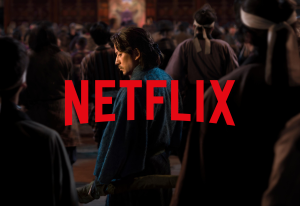For decades, the name Disney has been associated with brightly colored fairy tales that tell stories of good triumphing over evil, heartwarming lessons about true love, and the power of friendship saving the day, and, of course, happily ever afters. These classics are staples of childhood for generations of children and adults alike, giving us moments of pure joy and bright-eyed wonder. However, beneath the (mostly) family-friendly films lies an unsettling truth: things are not always as happily ever after as they seem. Re-watching some of these classics as an adult reveals scenes of shocking evil, dread, and horrifying violence that contrast with their G-ratings.
Videos by ComicBook.com
It’s a testament to the power of animation and storytelling that these dark moments not only made it past the studio’s strict censors (especially for some of the older films), but are now essential, if disturbing, parts of movie history.
7) Dumbo’s Circus (Dumbo)
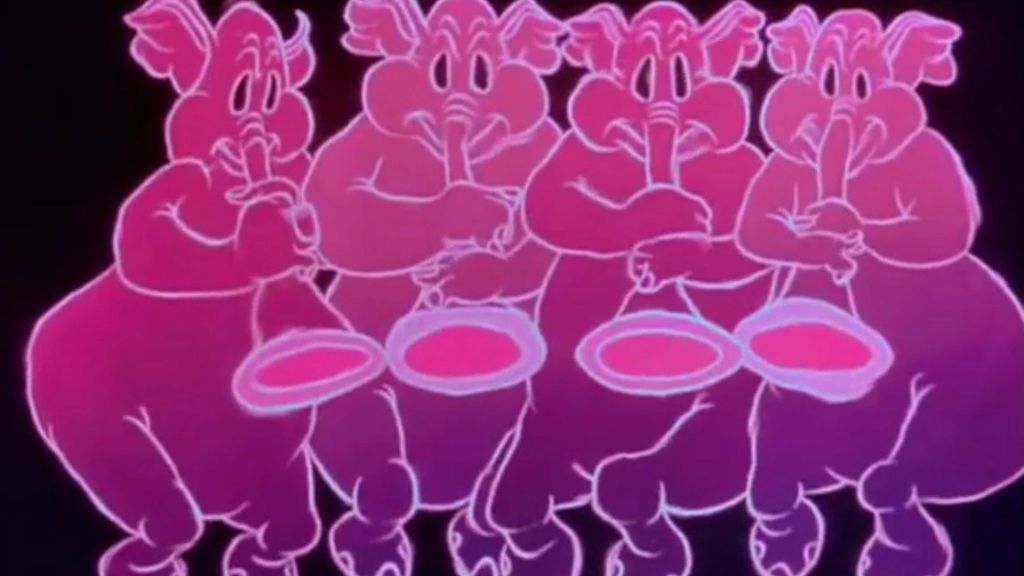
The entire premise of the “Pink Elephants on Parade” sequence from Dumbo is a horrifying descent into a surreal nightmare (one that I still shiver when thinking about it). After accidentally drinking alcohol, Dumbo and Timothy Mouse experience a fever dream that’s more like a bad trip, where elephants morph into monstrous, terrifying beings. The sequence is full of unsettling visions and frantic, disorienting music, creating a terrifying hallucination that lasts for several minutes, which seems to last an eternity when watching as a child.
It’s a bizarre subplot that feels entirely out of place in a gentle film about a flying elephant trying to find acceptance and his path in life. The sheer terror in the visuals, which include exploding elephants, disembodied eyes, and terrifying, shapeshifting figures, makes it a surprisingly intense and psychedelic experience. The “Pink Elephants on Parade” is a brief but vivid whiplash from a family-friendly classic into genuine psychological horror.
6) The Evil Queen Demanding Snow White’s Heart (Snow White and the Seven Dwarfs)

In the original, and arguably darkest, Disney movie, Snow White and the Seven Dwarfs, the Evil Queen’s jealousy drives her to an act of cold-blooded, premeditated murder (or at least an attempted murder-for-hire plot). She summons her loyal huntsman and demands that he take the pure and innocent princess, Snow White, deep into the forest and not only kill her, but to cut out her heart as a trophy for the Queen.
The very idea of a powerful queen with anything she desires at her disposal, instructing her trusted guard to carry out such a violent, personal crime against a young girl, and then proving he completed the deed by bringing back the human heart in a box is shocking. Though the huntsman ultimately spares Snow White due to her kindness and his humanity, the Queen’s intent is chillingly clear. This moment reveals that the Evil Queen is not merely a villain who lashes out unthinkingly and on a whim, but a truly wicked and terrifying person capable of plotting the most unimaginable evil, all for an unjustified desire for revenge.
5) Dr. Facilier’s Death (The Princess and the Frog)
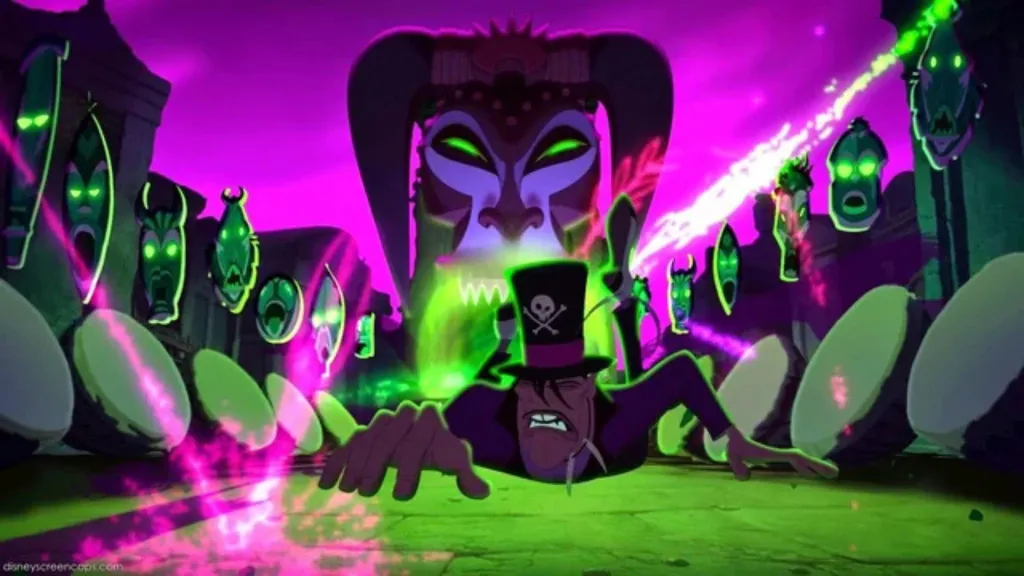
The manipulative Dr. Facilier, the smooth-talking villain of The Princess and the Frog, meets a spectacular and genuinely nightmarish end when his “friends on the other side” come to collect his debt. After the talisman protecting him from the dark souls looming just beyond the veil is destroyed, the Shadow Man is dragged screaming and clawing into the underworld by demonic, shadowy hands and faces appearing from the very ground beneath him.
While the Shadow Man sealed his own fate, it is still a shocking and supernatural display of a soul being literally pulled into Hell, complete with his terrified final expression being frozen onto a gravestone. His death and gravestone are both reminders of a pact with dark forces he thought he could outsmart, but that pact ultimately was fulfilled in a way that is far more terrifying than a simple fall or explosion. The scene is a loud, chaotic, and unmistakable representation of the eternal damnation Facilier earned by underestimating his “friends” and overestimating his own power.
4) The Huns Murdering a Whole Village (Mulan)
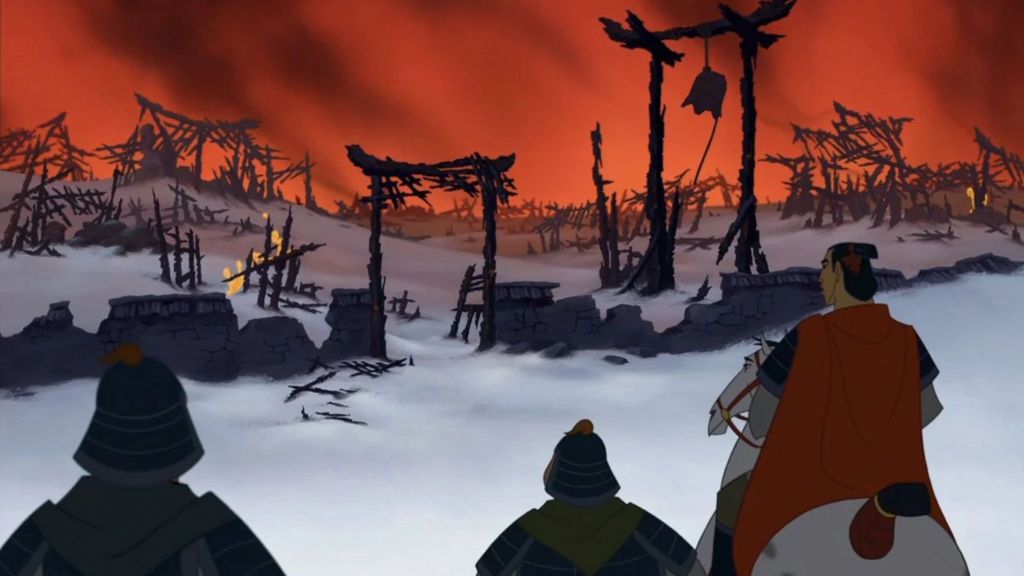
Mulan is, without a doubt, one of the most iconic movies of the Disney musical renaissance of the 1990s. A very chipper musical number—“A Girl Worth Fighting For”—is brought to a screeching halt when Mulan and her company find a horrifying scene that immediately ups the stakes of the film, taking it from an adventure about a girl trying to bring honor to her family into the brutalities of the war they are fighting. They discover a decimated mountain village, burned to the ground with no survivors. The destruction is beyond anything Mulan and her team have seen up until this point, and the camera lingers on a heartbreaking close-up of a small, discarded children’s doll resting amidst the burning ruins.
This brief, wordless sequence is devastating for the characters and the viewers, revealing the shocking reality of indiscriminate genocide without showing the violence itself. It turns the Huns from simple antagonists into an intangible threat into a clear and present danger to an entire nation, one that Li Shang is not sure his army can beat. The focus on the doll is the most powerful and gut-wrenching symbol that reminds the audience that entire families, including innocent children, have just been completely wiped out on a whim.
3) The Queen of Hearts Beheading People (Alice in Wonderland)
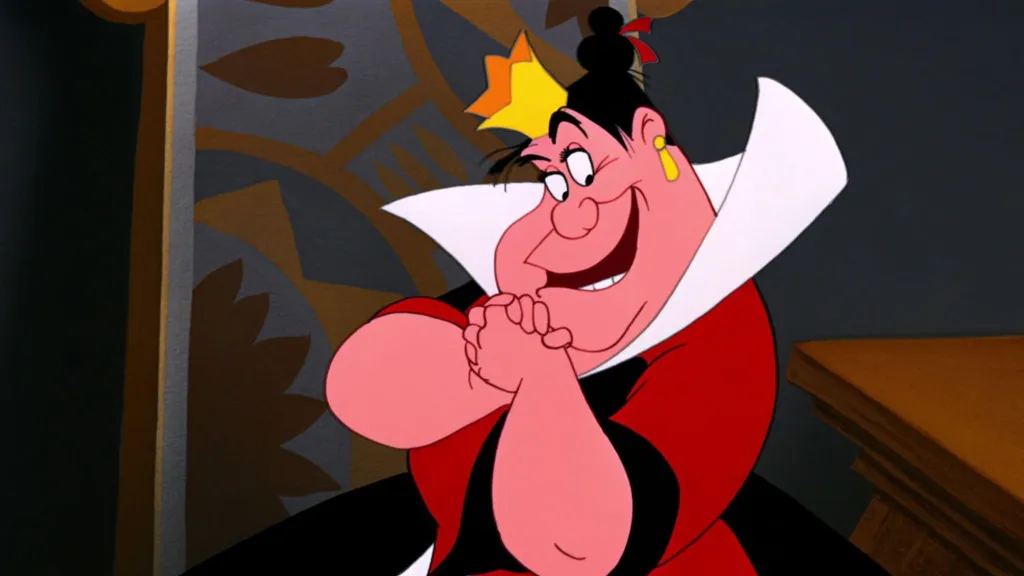
The tyrannical Queen of Hearts in Alice in Wonderland maintains her absolute control of the topsy-turvy and nonsensical world through constant, manic threats of execution. Her signature line, “off with their heads,” is shouted at any moment and any perceived wrongdoing, making the film’s whimsical world a terrifying police state ruled by an unstable, violent leader.
The humor in her character is derived from her irrational, explosive temper, yet her threats are never truly empty. She is surrounded by a court of terrified card soldiers and officials who live in constant fear of a sudden, brutal death and have no choice but to carry out her demands. The casual nature with which she orders beheadings, making capital punishment a routine part of her daily life, introduces a very dark side of cruelty into the funhouse world of Wonderland.
2) Mufasa’s Murder (The Lion King)
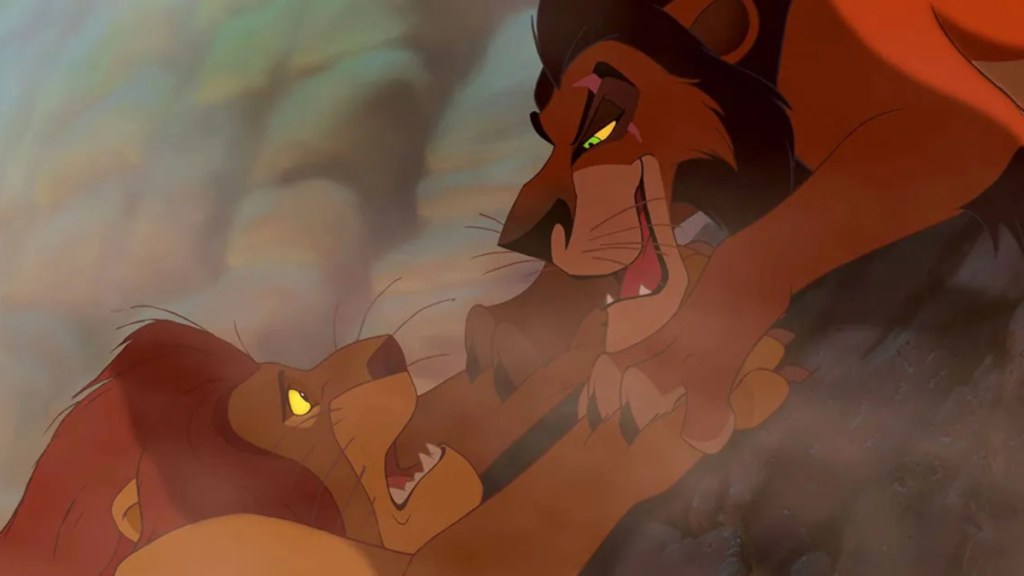
The central tragic event in The Lion King remains one of the most brutal and impactful scenes in Disney history. The cold-blooded, calculated murder of Mufasa by his own brother, Scar, is a shocking act of violence. Just when the viewer thinks Scar might respond to Mufasa’s cry for help—pleas for his life—Scar’s chilling whisper, “Long live the king,” followed by sending Mufasa plummeting to his death in a stampede, is an act of pure and unadulterated evil.
What makes this moment truly agonizing is that Simba was present for the entire ordeal, watching his father fall from the top of the valley. Even worse is Simba desperately trying to wake his father’s lifeless body, followed by Scar cruelly convincing the cub that he is responsible for his own beloved father’s death.
1) Hellfire (The Hunchback of Notre Dame)
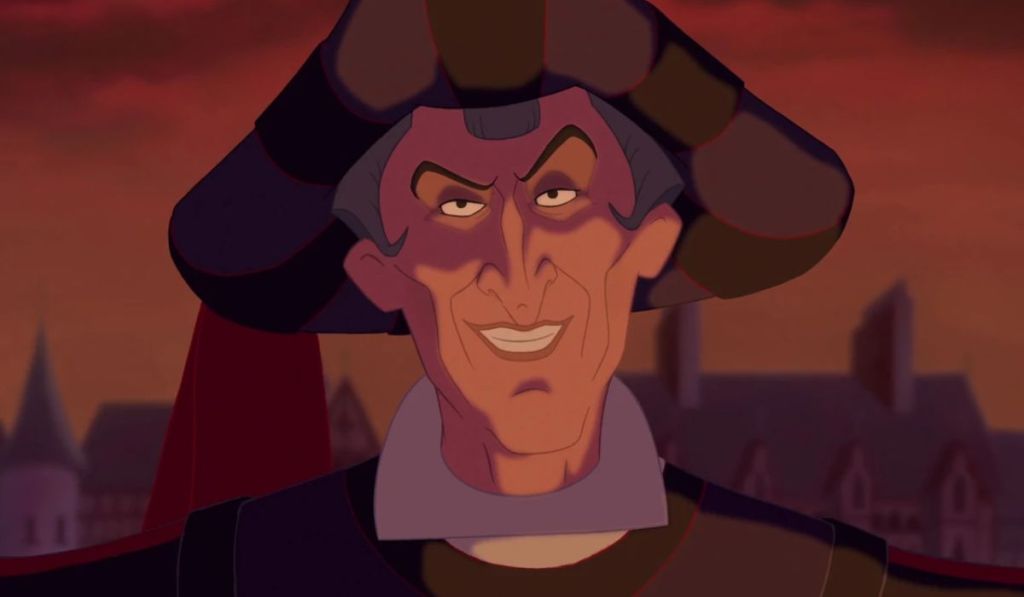
The showstopping and shocking fire-and-brimstone musical number “Hellfire” from The Hunchback of Notre Dame is arguably the darkest piece of content ever produced by Disney. Judge Claude Frollo, a powerful government official, sings an epic song expressing his lust for the innocent gypsy Esmeralda, which he attempts to rationalize as a mission given down from on high.
The song is a chilling self-justification for attempted murder and sexual assault, where Frollo wrestles with desire and religious fanaticism, asking the Virgin Mary to save him from Esmeralda by letting her “burn in hellfire, or live to be mine.” The number features terrifying imagery of hooded figures and flames, culminating in Frollo vowing to either possess her or commit genocide, making it a powerful and highly disturbing depiction of obsession, bigotry, and hypocrisy.
What do you think? Leave a comment below and join the conversation now in the ComicBook Forum!




